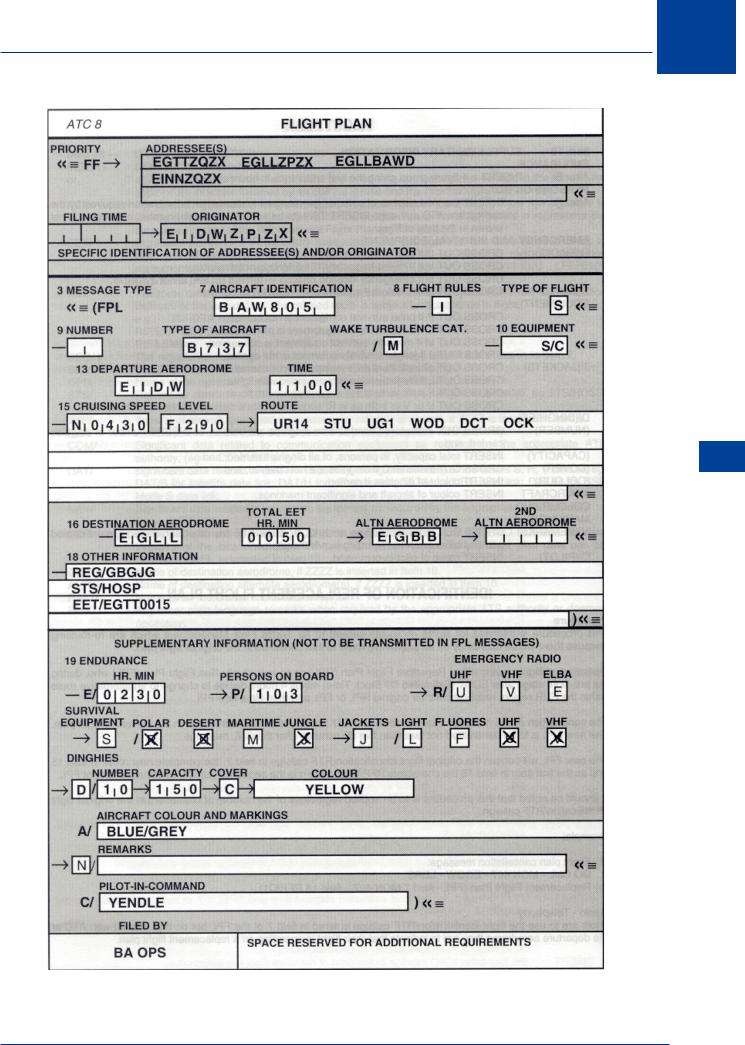
- •Textbook Series
- •Contents
- •1 Air Information Publications
- •Introduction
- •Format of an AIP
- •Automatic Terminal Information Service (ATIS)
- •Aerodrome Communication Facilities
- •Aerodrome Radio Navigation and Landing Aids
- •Other Sources
- •Search and Rescue
- •Questions
- •Answers
- •2 Fuel Policy and Fuel Monitoring
- •Universal Application of Fuel Policy
- •Realistic Trip Fuel
- •Reserve Fuel
- •Calculation of Contingency Fuel
- •Fuel Monitoring
- •Special Cases 1 – Decision Point Procedure
- •Special Cases 2 – Isolated Aerodrome Procedure
- •Questions
- •Answers
- •3 Nautical Air Miles
- •Nautical Air Miles
- •Questions
- •Answers
- •4 Single-engine Piston Aeroplane (SEP)
- •Introduction
- •Single-engine Piston Aeroplane
- •Cruise Power Settings Tables
- •Range Profile Figure
- •Endurance
- •Questions
- •Answers
- •5 Multi-engine Piston Aeroplane (MEP)
- •Introduction
- •MEP 1-Fuel, Time and Distance to Climb Data
- •MEP 1-Range at Standard Temperatures
- •MEP 1-Cruise Power Setting and Fuel Flow
- •MEP 1-True Airspeed
- •MEP 1-Endurance
- •MEP 1-Descent Fuel, Time and Distance
- •Questions
- •Answers
- •Introduction
- •Aeroplane Data and Constants
- •Optimum Cruise Altitude
- •Short Distance Cruise Altitude
- •Answers to Simplified Flight Planning
- •Questions
- •Answers
- •En Route Climb
- •Cruise/Integrated Range Tables
- •Questions
- •Answers
- •Descent Table
- •Exercise 1
- •Exercise 2
- •Answers to Integrated Flight Planning
- •8 MRJT Additional Procedures
- •ETOPS – CAP 697 MRJT1
- •Non-normal Operations
- •Fuel Tankering
- •Answers
- •9 Topographical Chart
- •Introduction
- •World Geodetic System of 1984 (WGS84)
- •Aeronautical Information
- •Topographical Information
- •Miscellaneous
- •Establishment of Minimum Flight Altitudes
- •The Minimum Grid Area Altitudes (Grid MORA)
- •Choosing Cruising Levels
- •Altimeter Errors and Corrections
- •Exercise 1
- •VFR Exercise 2
- •Answers
- •Exercise 1 Answers
- •VFR Exercise 2 Answers
- •10 Airways
- •Introduction
- •Air Traffic Services (ATS) Routes/Standard Routes
- •Area, Low and High Level Charts
- •Exercise 1
- •Exercise 2
- •Answers to Examples/Exercises
- •Answers Exercise 1
- •Answer Airways Exercise 2
- •Projection
- •Track Direction/Magnetic Variation/Distance
- •Grid Navigation
- •Exercise 1
- •Answers to Exercise 1
- •Exercise 2
- •Answers
- •AT(H/L) 1 & 2 Information
- •Exercise 3
- •12 ATC Flight Plan
- •Introduction
- •Definitions
- •Annexes to This Chapter
- •Specimen CA48
- •Item 19: Supplementary Information
- •Item 15
- •Use of DCT (Direct)
- •Exercise 1
- •Exercise 2
- •Exercise 3
- •Exercise 4
- •Answers
- •Annex 2
- •13 Point of Equal Time (PET)
- •Introduction
- •Derivation of Formula
- •The Effect of Wind on the Position of the PET:
- •Single Sector All-engine PET
- •Engine Failure PET
- •14 Point of Safe Return (PSR)
- •Introduction
- •Derivation of the Formula
- •Transposing the Formula to the Navigation Computer
- •The Effect of Wind on the Location of the PSR
- •Single Leg PSR
- •Derivation of the Formula for Variable Fuel Flows
- •15 Revision Questions
- •Revision Questions
- •Answers to Revision Questions
- •Specimen Examination Paper
- •Answers to Specimen Examination Paper
- •Explanations to Specimen Examination Paper
- •16 Index

Chapter
12
ATC Flight Plan
Introduction . . . . . . . . . . . . |
. . . . . . . . . . . . . . . . . . |
207 |
Definitions |
|
207 |
Annexes to This Chapter . . . . . . . . |
. . . . . . . . . . . . . . . . . . |
208 |
Specimen CA48 . . . . . . . . . . . . |
. . . . . . . . . . . . . . . . . |
208 |
Item 19: Supplementary Information . . . . |
. . . . . . . . . . . . . . . . . |
210 |
Item 15 |
|
210 |
Use of DCT (Direct) . . . . . . . . . . |
. . . . . . . . . . . . . . . . . . |
211 |
Exercise 1 . . . . . . . . . . . . . . |
. . . . . . . . . . . . . . . . . |
215 |
Exercise 2 . . . . . . . . . . . . . . |
. . . . . . . . . . . . . . . . . |
217 |
Exercise 3 . . . . . . . . . . . . . . |
. . . . . . . . . . . . . . . . . |
219 |
Exercise 4 . . . . . . . . . . . . . . |
. . . . . . . . . . . . . . . . . |
220 |
Answers . . . . . . . . . . . . . . |
. . . . . . . . . . . . . . . . . . |
224 |
Annex 1 - Flight Plan |
|
225 |
Annex 2 . . . . . . . . . . . . . . |
. . . . . . . . . . . . . . . . . . |
228 |
205

12 ATC Flight Plan
Plan Flight ATC 12
206

ATC Flight Plan
Introduction
References: ICAO Doc 4444-RAC/501; UK AIP ENR 1.10-FLIGHT PLANNING (25 Jul 13)
What is an ATC Flight Plan?
It is simply advance notice of a pilot’s intentions for a flight in terms of route (including departure and destination), cruising level and speed and information about the crew and passengers. It is in a set format to ensure completeness of information and compatibility with electronic data transfer between ATS and other units.
Students are required to understand, and answer questions on, all aspects of ATC Flight Plans, both individual and Repetitive Flight Plans (RPLs).
•Type of plan - individual or repetitive
•The format of an ICAO flight plan.
•The information required for the plan.
•How to complete, file, cancel or amend a flight plan.
Definitions
Flight plan: Specified information provided to air traffic service units, relative to an intended flight or portion of a flight of an aircraft.
Repetitive flight plan (RPL): A flight plan related to a series of frequently recurring, regularly operated individual flights with identical basic features, submitted by an operator for retention and repetitive use by ATS units. These flights must be operated on the same day(s) of consecutive weeks and on at least 10 occasions, or every day over a period of at least 10 consecutive days. The elements of each flight shall have a high degree of stability.
Filed flight plan: The flight plan as filed with an ATS unit by the pilot or a designated representative, without any subsequent changes.
Current flight plan: The flight plan, including changes, if any, brought about by subsequent clearances.
Estimated elapsed time: The estimated time required to proceed from one significant point to another.
Estimated off-block time: The estimated time at which the aircraft will commence movement associated with departure.
Estimated time of arrival: For IFR flights, the time at which it is estimated that the aircraft will arrive over that designated point, defined by reference to navigational aids, from which it is intended that an instrument approach will be commenced, or, if no navigational aid is associated with the aerodrome, the time at which the aircraft will arrive over the aerodrome. For VFR flights, the time at which it is estimated the aircraft will arrive over the aerodrome.
(Extract from ICAO DOC 4444 (PANS-RAC) Dated 22 Nov 07)
12
ATC Flight Plan 12
207

12 ATC Flight Plan
Annexes to This Chapter
Plan Flight ATC 12
•Annex 1 to this chapter is a copy of Part II, Chapter 8, Doc 4444, relating to the rules for ATC flight plans.
•Annex 2 to this chapter, INSTRUCTIONS FOR THE COMPLETION OF THE FLIGHT PLAN FORM, is an extract of Appendix 2, Doc 4444.
These annexes should be studied carefully as they may be a source of examination questions.
Specimen CA48
Reference Figure 12.1 and Annex 2 to this chapter.
The numbered items at Figure 12.1 should be referred to in conjunction with the apposite instructions at Annex 2.
For example: Item 7 AIRCRAFT IDENTIFICATION in Figure 12.1
Briefly, the instructions for ITEM 7: AIRCRAFT IDENTIFICATION at Annex 2, state that the aircraft identification should not exceed 7 characters and can be either the registration markings of the aircraft or the ICAO designator for the operating agency.
ITEMS 7, 8, 9, 10, 13, 16, 18, and 19 can be readily understood from the instructions.
ITEM 15: ROUTE is more complex and will be discussed later.
Decode of Specimen Flight Plan
The aircraft identification is BAW805, (Speedbird 805 being the radio-telephony identification). IFR Scheduled flight for a Boeing 737, which creates a Medium wake turbulence. The aircraft has a serviceable Standard communication/navigation/approach aid equipment for the route and a serviceable SSR transponder with 4096 codes and Mode C. The departure airfield is EIDW, (Dublin) with an estimated off-block time of 1100 UTC. The first cruising speed is 430 kt TAS, N0430, at Flight Level 290, F290.
208

ATC Flight Plan 12
ATC Flight Plan 12
Figure 12.1 Specimen ATC flight plan
209
